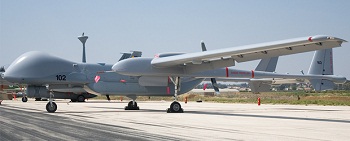 |
| The Israeli-manufactured Heron TP drone, also known as the IAI Eitan ('strong' in Hebrew), is one of three Israeli drone platforms Iran believes is based in Azerbaijan to launch "secret spy missions" against its territory. |
In recent weeks, Iran has repeatedly accused Israel and Azerbaijan of conducting what Iran believes to be "secret spy missions" that use Israeli-manufactured drones taking off from Azeri airbases.
Rumors of Israeli drones stationed in Azerbaijan first emanated from a Sunday Times report [full article mirrored here] on Dec. 2, which implied that Israeli-manufactured Heron TP-II drones armed with American Hellfire missiles were based at undisclosed locations in Azerbaijan. The Heron TP-II drone, also known as IAI Eitan ('strong' in Hebrew), is one of the most advanced aerial drone platforms used by the Israeli Defense Forces.
On Dec. 9, Iranian Press TV accused Azerbaijan and Israel of carrying out joint spying missions over Iran's shared border with Karabakh. Iran also claimed that Israeli military advisers were present in Azerbaijan, and that Israeli-made Hermes-450 drones as well as the Orbiter Mini unmanned aerial vehicle (UAV) System were being used to conduct aerial surveillance missions over Iranian territory. Azerbaijan has acquired 10 Hermes-450 drones between 2009 and 2012, and Azerbaijan reportedly had acquired five Heron TP-II and five Searcher UAVs through a $1.6 billion defense contract with Israel, according to a Fars News report from April of this year.
Officials from Israel and Azerbaijan have denied the allegations. Shortly after the initial disclosure by the Sunday Times, Azeri Foreign Ministry spokesman Elman Abdullayev stated: "Azerbaijan's position has been voiced several times. Baku will never allow its territory be used against neighbors .... Azerbaijan maintains good neighborly relations [with Iran] and will never take such a step. This is our position."
Meanwhile, Iranian officials publicly threatened to use force against incursions into Iranian territory and perceived violations of its airspace. "To cross into our airspace, they should first of all be able to disorient our defense systems. Those who will cross into our airspace will receive a sharp counterblow, taking into consideration the capabilities of Iran's Armed Forces in defending the borders of our country," Iranian Foreign Ministry spokesman Ramin Mehmanparast told reporters on Dec. 13.
Iranian concerns over incursions into its airspace and overflights of its territory by Western and Israeli forces have spiked since November. On Nov. 1, Iranian aerial assets fired several missiles at a US drone but missed, near Kargh Island, located in the Persian Gulf approximately 16 miles off the coast of Iran. A few days later, Iranian Foreign Minister Ali-Akbar Salehi threatened that Iran would take legal action against the US in international courts over its "drone incursion" into Iranian airspace over the Persian Gulf.
In early December, Iranian Republican Guard naval elements claimed to have captured an American Scan Eagle drone near Khargh Island, and later broadcast images of the drone. American military officials vehemently denied the loss of any drone assets in the Persian Gulf. [See Threat Matrix, Iranian regime broadcasts video of 'captured' US drone].